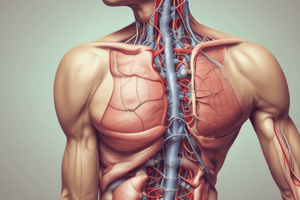Podcast
Questions and Answers
Which system is responsible for bringing oxygen into the body and removing carbon dioxide?
Which system is responsible for bringing oxygen into the body and removing carbon dioxide?
- Circulatory system
- Digestive system
- Endocrine system
- Respiratory system (correct)
What is the primary function of the nervous system?
What is the primary function of the nervous system?
- To defend the body against pathogens and diseases
- To break down food into nutrients
- To transport oxygen and nutrients to the body's cells
- To control body functions and interpret stimuli (correct)
What is the primary function of the epithelial tissue?
What is the primary function of the epithelial tissue?
- To contract and move the body
- To form linings and glands (correct)
- To transmit and process information
- To support and connect body parts
Which body region contains the brain and sensory organs?
Which body region contains the brain and sensory organs?
What is the primary function of the circulatory system?
What is the primary function of the circulatory system?
Flashcards are hidden until you start studying
Study Notes
Human Anatomy
Organ Systems
- Nervous System: controls body functions, interprets and responds to stimuli
- Central Nervous System (CNS): brain, spinal cord
- Peripheral Nervous System (PNS): nerves, ganglia
- Circulatory System: transports oxygen, nutrients, and waste
- Heart: pumps blood
- Arteries: carry oxygenated blood away from heart
- Veins: carry deoxygenated blood back to heart
- Respiratory System: brings oxygen into body, removes carbon dioxide
- Lungs: exchange oxygen and carbon dioxide
- Trachea: airway connecting lungs to throat
- Digestive System: breaks down food into nutrients
- Mouth: mechanical and chemical digestion
- Esophagus: food transport to stomach
- Stomach: chemical digestion
- Small intestine: nutrient absorption
- Large intestine: water absorption, waste storage
- Endocrine System: produces hormones regulating body functions
- Pituitary gland: regulates hormone production
- Thyroid gland: regulates metabolism
- Adrenal glands: regulates stress response
- Immune System: defends against pathogens and diseases
- White blood cells: fight infections
- Lymph nodes: filter out pathogens
- Spleen: filters blood, stores immune cells
Human Body Organization
- Cells: basic structural and functional units
- Cell membrane: regulates what enters and leaves cell
- Cytoplasm: site of cellular activities
- Nucleus: contains genetic material
- Tissues: groups of similar cells performing specific functions
- Epithelial tissue: forms linings and glands
- Connective tissue: supports and connects body parts
- Muscle tissue: contracts and moves body
- Nervous tissue: transmits and processes information
- Organs: structures composed of two or more tissue types
- Heart: pumps blood
- Lungs: exchange oxygen and carbon dioxide
- Liver: detoxifies, regulates metabolism
- Kidneys: filter waste, regulate electrolytes
Body Regions
- Head: contains brain, sensory organs
- Neck: connects head to torso
- Thorax: contains heart, lungs
- Abdomen: contains digestive organs
- Pelvis: contains reproductive organs
- Upper limb: arm, forearm, hand
- Lower limb: thigh, leg, foot
Organ Systems
- Nervous System
- Controls body functions and interprets/responds to stimuli
- Divided into Central Nervous System (brain, spinal cord) and Peripheral Nervous System (nerves, ganglia)
- Circulatory System
- Responsible for transporting oxygen, nutrients, and waste
- Heart pumps blood, arteries carry oxygenated blood away from heart, and veins carry deoxygenated blood back to heart
- Respiratory System
- Brings oxygen into body and removes carbon dioxide
- Lungs exchange oxygen and carbon dioxide, trachea connects lungs to throat
- Digestive System
- Breaks down food into nutrients
- Involves mechanical and chemical digestion in mouth, esophagus transports food to stomach, stomach performs chemical digestion, small intestine absorbs nutrients, and large intestine absorbs water and stores waste
- Endocrine System
- Produces hormones regulating body functions
- Pituitary gland regulates hormone production, thyroid gland regulates metabolism, and adrenal glands regulate stress response
- Immune System
- Defends against pathogens and diseases
- White blood cells fight infections, lymph nodes filter out pathogens, and spleen filters blood and stores immune cells
Human Body Organization
- Cells
- Basic structural and functional units of body
- Cell membrane regulates what enters and leaves cell, cytoplasm site of cellular activities, and nucleus contains genetic material
- Tissues
- Groups of similar cells performing specific functions
- Epithelial tissue forms linings and glands, connective tissue supports and connects body parts, muscle tissue contracts and moves body, and nervous tissue transmits and processes information
- Organs
- Structures composed of two or more tissue types
- Examples: heart pumps blood, lungs exchange oxygen and carbon dioxide, liver detoxifies and regulates metabolism, and kidneys filter waste and regulate electrolytes
Body Regions
- Head
- Contains brain and sensory organs
- Neck
- Connects head to torso
- Thorax
- Contains heart and lungs
- Abdomen
- Contains digestive organs
- Pelvis
- Contains reproductive organs
- Upper Limb
- Consists of arm, forearm, and hand
- Lower Limb
- Consists of thigh, leg, and foot
Studying That Suits You
Use AI to generate personalized quizzes and flashcards to suit your learning preferences.




